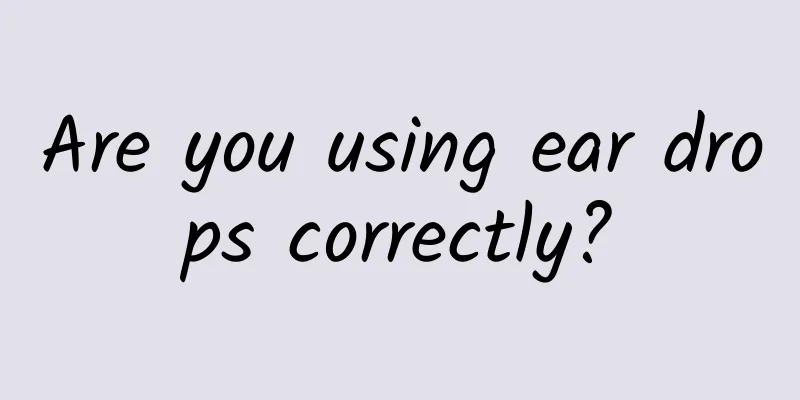Are you using ear drops correctly?

|
The ear is an important sensory organ for humans to communicate and listen to sounds. Although the ear is small, if you suffer from ear disease, it will bring a lot of trouble to your life. Common ear diseases include cerumen embolism, otitis externa, secretory otitis media, suppurative otitis media, etc. Ear drops are commonly used drugs for the treatment of ear diseases. Through ear drops, the drug can be delivered directly to the local lesion. 1. Common types of ear drops and their indications are: 1. 3-5%. Sodium bicarbonate ear drops: also known as cerumen water, can dissolve and soften cerumen (earwax) and crusts. After dropping them, you will feel stuffy ears, hearing loss, and even ear pain. This is because sodium bicarbonate softens and swells the earwax. 2. Antibiotics: such as ofloxacin ear drops, levofloxacin ear drops, etc., can be used for otitis externa, otitis media, myringitis, suppurative otitis media, etc. caused by sensitive bacteria. 3. Phenol glycerin ear drops: mainly used for acute otitis media (before the eardrum is perforated) and external otitis, sterilization, analgesia and swelling reduction. (Can be used for eardrum congestion and unbearable pain.) 4. Disinfection: such as 3% hydrogen peroxide solution (hydrogen peroxide), a strong oxidant, has the functions of disinfection, antibacterial, cleaning, deodorization, changing the pH value of the ear canal environment, and inhibiting the growth of bacteria and fungi. It is suitable for suppurative otitis externa and otitis media. 2. Conventional use of ear drops 1. Clean your hands before applying the medicine, gently clean the outer ear with a cotton swab, and gently wipe the secretions in the ear canal. 2. When taking the medicine, the patient should sit or lie on his side with the affected ear facing up. For adults, pull the auricle upward and backward, and for children, pull it downward and backward to straighten the curved external auditory canal. 3. Place the ear drops into the ear according to the instructions or the doctor's instructions. If the ear drops are suspensions, shake them well before use. 4. After applying the medicine, you can swallow your saliva and gently press the tragus several times to allow the medicine to enter the deep part of the ear canal. 5. Maintain the posture for 5-10 minutes to promote the penetration of the medicine into the ear canal. 6. Use a tissue to wipe off excess liquid around the ear and store the remaining ear drops according to the storage conditions required by the instructions. 3. What should you pay attention to when using ear drops? 1. When using ear drops, especially in winter, you should hold the ear drops in your palm to warm them up to body temperature, so as to avoid the cold liquid irritating the inner ear and causing dizziness and nausea. (Remember not to warm the ear drops in hot water to avoid affecting the quality of the medicine, and too high a temperature will also stimulate the vestibule and cause discomfort.) 2. When applying ear drops, do not let the mouth of the ear drop bottle touch the ear (also avoid touching the bottle mouth with your hands or objects) to avoid contaminating the medicine or injuring the ear. 3. When several kinds of medicine need to be used alternately, different ear drops can be used alternately in the ears at intervals of 1-2 hours. 4. Once opened, ear preparations should not be used for more than 4 weeks. If they become cloudy or discolored, they should be discarded immediately. 5. The selection and duration of use of ear drops should be based on the doctor's advice. Self-medication or prolonged treatment is not recommended. 6. Ear drops should be used by one person only to prevent cross infection. (Chief Pharmacist of Kaifeng Children's Hospital: Zhao Min) References: [1] Instructions for use of Ofloxacin Ear Drops [2] 3% Hydrogen Peroxide Solution Instructions [3] Xu Zhengmin, Zhang Jianji. Diagnosis and treatment of acute otitis media in children: Clinical practice guidelines (developed in 2015)[J]. Chinese Journal of Practical Pediatrics, 2016, 31(02):81-84. [4] Chinese Pharmacopoeia Committee. Pharmacopoeia of the People's Republic of China [M]. Beijing: China Medical Science and Technology Press, 2020. |
<<: First report in China! The disease is related to clothing disinfectant
>>: Expiration date of medicine after opening
Recommend
Women experience stinging pain when urinating
There is a stinging feeling when urinating, which...
Endometrial stratification
Maybe many female friends don’t know that the end...
What does leucorrhea bacterial culture check?
Some female friends do not pay much attention to ...
What are the methods for treating fallopian tube adhesions?
The treatment of fallopian tube adhesion is very ...
Yellow discharge during pregnancy
If yellow discharge occurs during the fourth mont...
What are the harms of vulvar leukoplakia to the body
Vulvar leukoplakia is a disease symptom that is v...
Can I eat golden silk dates during menstruation?
Pay attention to keeping warm, pay attention to d...
How to relieve abdominal pain during menstrual period?
Normally, women will have their periods after the...
White stuff coming out of the vagina
The vulva may come into contact with white things...
There is a nipple on the accessory breast
Having accessory breasts is very unsightly. First...
What is the reason for missing menstrual period?
With the continuous development of social economy...
Why do I feel ear pain when I'm on an airplane, but I just need to swallow a few times to get rid of it?
Author: Kang Xiaoyan, First Hospital of Shanxi Me...
What causes pain in the left side of the waist and abdomen in women?
Pain in the left side of the waist and abdomen is...
My period is delayed for ten days, why is it not coming?
Delayed menstruation is a common problem among mo...
Are the ten days before menstruation the dangerous period?
What is the dangerous period of pregnancy and wha...









